 Hello. Back to reality after some months of hard works on a book that will be published during next spring. More information later. In this post, I will rather focus on a new project we have begun with my friend Claude Lattaud of Paris V university. This project is called the "green tamagotchi project" after the great commercial success of Bandai's game. The idea is to take care of a plant on your mobile phone. You will be able to change light, put water, some fertilizer, and see the growth of a virtual plant. After some days you'll get a beautiful plant with green leaves and flowers. You could then send it to your wife for her birthday or add it to your virtual garden on your PC... There will be a large variety of seeds and you will be also able to create new species. We used an advanced 3D L-System engine for the artificial life part of the project. The image shows a view of the work in progress prototype on a mobile phone simulator. We also work on the user interface that must be usable by any mobile phone owner. Any company interested in this project can contact me...
Hello. Back to reality after some months of hard works on a book that will be published during next spring. More information later. In this post, I will rather focus on a new project we have begun with my friend Claude Lattaud of Paris V university. This project is called the "green tamagotchi project" after the great commercial success of Bandai's game. The idea is to take care of a plant on your mobile phone. You will be able to change light, put water, some fertilizer, and see the growth of a virtual plant. After some days you'll get a beautiful plant with green leaves and flowers. You could then send it to your wife for her birthday or add it to your virtual garden on your PC... There will be a large variety of seeds and you will be also able to create new species. We used an advanced 3D L-System engine for the artificial life part of the project. The image shows a view of the work in progress prototype on a mobile phone simulator. We also work on the user interface that must be usable by any mobile phone owner. Any company interested in this project can contact me...Saturday, October 21, 2006
Virtual Plants on Mobile Phones
 Hello. Back to reality after some months of hard works on a book that will be published during next spring. More information later. In this post, I will rather focus on a new project we have begun with my friend Claude Lattaud of Paris V university. This project is called the "green tamagotchi project" after the great commercial success of Bandai's game. The idea is to take care of a plant on your mobile phone. You will be able to change light, put water, some fertilizer, and see the growth of a virtual plant. After some days you'll get a beautiful plant with green leaves and flowers. You could then send it to your wife for her birthday or add it to your virtual garden on your PC... There will be a large variety of seeds and you will be also able to create new species. We used an advanced 3D L-System engine for the artificial life part of the project. The image shows a view of the work in progress prototype on a mobile phone simulator. We also work on the user interface that must be usable by any mobile phone owner. Any company interested in this project can contact me...
Hello. Back to reality after some months of hard works on a book that will be published during next spring. More information later. In this post, I will rather focus on a new project we have begun with my friend Claude Lattaud of Paris V university. This project is called the "green tamagotchi project" after the great commercial success of Bandai's game. The idea is to take care of a plant on your mobile phone. You will be able to change light, put water, some fertilizer, and see the growth of a virtual plant. After some days you'll get a beautiful plant with green leaves and flowers. You could then send it to your wife for her birthday or add it to your virtual garden on your PC... There will be a large variety of seeds and you will be also able to create new species. We used an advanced 3D L-System engine for the artificial life part of the project. The image shows a view of the work in progress prototype on a mobile phone simulator. We also work on the user interface that must be usable by any mobile phone owner. Any company interested in this project can contact me...Monday, May 29, 2006
3D Biomorphs
 As some of you may probably know, I am very interested in Biomorphs since the design of the Lifedrop virtual ecosystem (see the LifeDrop page on the right). In LifeDrop, the virtual water drop is like a 3D sphere with simple physical simulation. Biomorphs are true autonomous agents and their 3D shapes are based on the original Richard Dawkins recursive procedure simply called Tree in the Blind Watchmaker program. Concerning the 3D rendering, I have just made a small adaption to this original 2D routine in order to have some "legs" in 3D. However, I am not very satisfied by this approach. I would be very interested if someone has already found a better way for drawing 3D Biomorphs. The problem is that procedure not only needs to show the same properties as in 2D, but also a much better rendering. As an example of a better rendering in 2D, the image shows "Mandelbrotset Biomorph" which has been computed using Mathematica (see http://www.bugman123.com/Fractals/Fractals.html for details). However, since LifeDrop runs multiple Biomorphs agents in parallel, the drawing procedure must be optimized to obtain fast rendering. All theses points make the problem hard to solve. However, I think it is possible and when this point will be resolved, I will update LifeDrop.
As some of you may probably know, I am very interested in Biomorphs since the design of the Lifedrop virtual ecosystem (see the LifeDrop page on the right). In LifeDrop, the virtual water drop is like a 3D sphere with simple physical simulation. Biomorphs are true autonomous agents and their 3D shapes are based on the original Richard Dawkins recursive procedure simply called Tree in the Blind Watchmaker program. Concerning the 3D rendering, I have just made a small adaption to this original 2D routine in order to have some "legs" in 3D. However, I am not very satisfied by this approach. I would be very interested if someone has already found a better way for drawing 3D Biomorphs. The problem is that procedure not only needs to show the same properties as in 2D, but also a much better rendering. As an example of a better rendering in 2D, the image shows "Mandelbrotset Biomorph" which has been computed using Mathematica (see http://www.bugman123.com/Fractals/Fractals.html for details). However, since LifeDrop runs multiple Biomorphs agents in parallel, the drawing procedure must be optimized to obtain fast rendering. All theses points make the problem hard to solve. However, I think it is possible and when this point will be resolved, I will update LifeDrop.Wednesday, April 26, 2006
Les indispensables
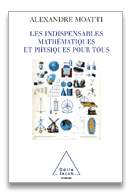 Une fois n'est pas coutume, un post en français car le sujet s’y prête. Il s’agit d’un coup de projecteur sur le livre d’Alexandre Moatti édité par Odile Jacob : Les indispensables – Mathématiques et Physiques pour tous. Un excellent livre de culture générale scientifique qui a le mérite de couvrir effectivement " les indispensables " : nombre d’or, nombres parfaits et amicaux, quadrature du cercle et courbes fractales, vitesse de la lumière et trous noirs, théorème de Gödel et relation d’incertitude, relativité et théorie du chaos. Même dans le domaine relativement pointu des créatures artificielles, et a fortiori pour tous ceux qui s’intéressent aux sciences de la complexité, la lecture rafraîchissante de ce livre apportera une perspective intéressante : il est possible en effet de présenter des concepts et des théories jugés souvent " trop compliqués " de façon simple et compréhensible, sans introduire un décalage entre le scientifique et l’honnête homme du XXIe siècle.
Une fois n'est pas coutume, un post en français car le sujet s’y prête. Il s’agit d’un coup de projecteur sur le livre d’Alexandre Moatti édité par Odile Jacob : Les indispensables – Mathématiques et Physiques pour tous. Un excellent livre de culture générale scientifique qui a le mérite de couvrir effectivement " les indispensables " : nombre d’or, nombres parfaits et amicaux, quadrature du cercle et courbes fractales, vitesse de la lumière et trous noirs, théorème de Gödel et relation d’incertitude, relativité et théorie du chaos. Même dans le domaine relativement pointu des créatures artificielles, et a fortiori pour tous ceux qui s’intéressent aux sciences de la complexité, la lecture rafraîchissante de ce livre apportera une perspective intéressante : il est possible en effet de présenter des concepts et des théories jugés souvent " trop compliqués " de façon simple et compréhensible, sans introduire un décalage entre le scientifique et l’honnête homme du XXIe siècle.Tuesday, April 18, 2006
Daedalus and Artifical Creatures
 This is a photo of the Knossos's palace taken last week during my vacation in Crete : in greek mythology, this is the famous "Labyrinth" which was an elaborate maze constructed by King Minos of Crete and designed by Daedalus to hold the Minotaur, a man-eating monster that was half man and half bull. Daedalus is an important figure in the history of artificial creatures. He was a great architect and sculptor who's said to have created wooden "moving statues" and many other artifacts : he has built for Minos' wife, Pasiphae, a wooden cow so she could mate with the Minotaur ; he has fabricated wings for himself and his young son Icarus to escape from Crete, but Icarus flew too near the sun and fell into the sea. It is very difficult to know if Daedalus, like Minos itself, have really existed or if it is only a myth like many others in the antic greek legendary tales. However, the fact is that the palace exists and has been dated around 1700 B.C. (bronze age period) that is over 3500 years old.
This is a photo of the Knossos's palace taken last week during my vacation in Crete : in greek mythology, this is the famous "Labyrinth" which was an elaborate maze constructed by King Minos of Crete and designed by Daedalus to hold the Minotaur, a man-eating monster that was half man and half bull. Daedalus is an important figure in the history of artificial creatures. He was a great architect and sculptor who's said to have created wooden "moving statues" and many other artifacts : he has built for Minos' wife, Pasiphae, a wooden cow so she could mate with the Minotaur ; he has fabricated wings for himself and his young son Icarus to escape from Crete, but Icarus flew too near the sun and fell into the sea. It is very difficult to know if Daedalus, like Minos itself, have really existed or if it is only a myth like many others in the antic greek legendary tales. However, the fact is that the palace exists and has been dated around 1700 B.C. (bronze age period) that is over 3500 years old.Sunday, March 26, 2006
Eonomic Instability
 In this post, I want to focus on a very interesting paper published by Y. Louzoun et. al. in 2003 (Artificial Life vol. 9 n. 4 - MIT Press). Their paper shows that world-size global market lead to economic instability. The model is based on an extended Lokta-Voltera equation applied on a two-dimensional lattice with two main parameters: R is the range over which competition between agents can take place, and D is a diffusion coefficient of wealth. They argue that extreme values for globalization R and redistribution D, as advocated respectively by extreme capitalism and extreme socialism, are equally counterproductive and possibly disastrous due to catastrophic fluctuations. However, there is a regional globalization scale that seems to optimize the system. They conclude that moderate-size regional markets (R ~ system size / 10) partially protected from external competition, are the optimal economic configuration. Well, I would like to have enough time to be able to work on that subject. Interesting, no ? (Earth image from space - Courtesy Nasa).
In this post, I want to focus on a very interesting paper published by Y. Louzoun et. al. in 2003 (Artificial Life vol. 9 n. 4 - MIT Press). Their paper shows that world-size global market lead to economic instability. The model is based on an extended Lokta-Voltera equation applied on a two-dimensional lattice with two main parameters: R is the range over which competition between agents can take place, and D is a diffusion coefficient of wealth. They argue that extreme values for globalization R and redistribution D, as advocated respectively by extreme capitalism and extreme socialism, are equally counterproductive and possibly disastrous due to catastrophic fluctuations. However, there is a regional globalization scale that seems to optimize the system. They conclude that moderate-size regional markets (R ~ system size / 10) partially protected from external competition, are the optimal economic configuration. Well, I would like to have enough time to be able to work on that subject. Interesting, no ? (Earth image from space - Courtesy Nasa).Monday, March 13, 2006
Al-Jazari Automata
 Yesterday, I have visited the "The Golden Age of Arabic Sciences" exhibition at the Arabic World Institute in Paris. Among a very good selection of many scientific discoveries of this civilisation, it was an opportunity to see some documents written by Al-Jazari. Ibn Ismail Ibn al-Razzaz Al-Jazari (1206 AD) was one of history's greatest engineers. He invented many automata and some of the first mechanical clocks, driven by water and weights. He was called Al-Jazari after the area where he was born, Al-Jazira, which is the traditional Arabic name for northern Mesopotamia. Al-Jazari draws on the works of its predecessors both from the Greeks (Philon, Heron and Archimede) and Islamic world (Banu Musa brothers, Al-Khuwarizmi and Ridwan). His contribution was very important for the diffusion of knowledge in the Arabic world and after in Europe due to the translations of his books like "The Book of Knowledge of Ingenious Mechanical Devices" which contains more than 150 automata and mechanical devices. I take the picture in the museum showing a page of "A Compendium on the Theory and Practice of the Mechanical Arts" dated 1315-1316 (AD). The picture shows the internal structure of an automata for serving and arbitrating drinking sessions. That is to say that Al-jazira has an important place in the history of artificial creatures.
Yesterday, I have visited the "The Golden Age of Arabic Sciences" exhibition at the Arabic World Institute in Paris. Among a very good selection of many scientific discoveries of this civilisation, it was an opportunity to see some documents written by Al-Jazari. Ibn Ismail Ibn al-Razzaz Al-Jazari (1206 AD) was one of history's greatest engineers. He invented many automata and some of the first mechanical clocks, driven by water and weights. He was called Al-Jazari after the area where he was born, Al-Jazira, which is the traditional Arabic name for northern Mesopotamia. Al-Jazari draws on the works of its predecessors both from the Greeks (Philon, Heron and Archimede) and Islamic world (Banu Musa brothers, Al-Khuwarizmi and Ridwan). His contribution was very important for the diffusion of knowledge in the Arabic world and after in Europe due to the translations of his books like "The Book of Knowledge of Ingenious Mechanical Devices" which contains more than 150 automata and mechanical devices. I take the picture in the museum showing a page of "A Compendium on the Theory and Practice of the Mechanical Arts" dated 1315-1316 (AD). The picture shows the internal structure of an automata for serving and arbitrating drinking sessions. That is to say that Al-jazira has an important place in the history of artificial creatures.Saturday, March 11, 2006
Digital Life and Evolution
 In the famous Science-Fiction Hyperion book series written by Dan Simmons, the evolution of small virus programs in the Internet leads to the Infosphere. The story begins with Tom Ray’s Tierra project and ends with Artificial Intelligences, cybrids, and other virtual creatures. Is that possible ?
In the famous Science-Fiction Hyperion book series written by Dan Simmons, the evolution of small virus programs in the Internet leads to the Infosphere. The story begins with Tom Ray’s Tierra project and ends with Artificial Intelligences, cybrids, and other virtual creatures. Is that possible ?There is a long story of virtual ecosystems research projects : Tierra, Avida, LifeDrop and many others (left image shows a typical LifeDrop run - you can experiment it by following the LifeDrop link on the right). All these programs are based on the evolution of digital organisms by means of “digital DNA” mutations and cross-overs. Another characteristic is that these programs use a virtual machine layer between the computer operating system and the creatures. This virtual machine creates a more suitable environment for bio-inspired digital creatures and it represents also a sort of protection barrier between the system and the outside computer world. After more than a decade of research, some digital organisms are getting closer to fulfilling the definition of biological life : most of the features that biologists have said were necessary for life we can check off. These experiments raise multiple questions: What is the definition of life ? Are some of these digital creatures really alive ? Is the evolution in such systems really open-ended ? Is it possible to create digital organisms directly in the computer memory without any ecosystem simulation ? Well, I’ll try to address some of these important questions in future posts… Keep tuned.
Friday, March 03, 2006
Modeling Stock Markets with Cellular Automata
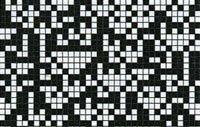 In the recent years, there has been an increasing interest in simulating financial systems using multi-agent models and Cellular Automata (CA). There is a strong feeling that financial markets are typical complex systems in which the global dynamical properties mainly depend on the evolution of a large number of non-linear interacting agents. An extreme view of this is to consider that much of the randomness of financial markets is the consequence of their dynamics and has little to do with the nature or value what is being trade. This is in contrast with classical models that assume that investors are rational and consider the price a random walk. In his book "A New Kind of Science", Stephen Wolfram has proposed a very simple and idealized model of a stock market. It is a one-dimensional CA where each cell corresponds to an entity that either buys or sells on each step. The behavior of a given cell is determined by the one of its two neighbors at the preceding step (see diagrams (C) S. Wolfram). The application on this rule results in a sort of random behavior that look likes those seen on stock markets curves.
In the recent years, there has been an increasing interest in simulating financial systems using multi-agent models and Cellular Automata (CA). There is a strong feeling that financial markets are typical complex systems in which the global dynamical properties mainly depend on the evolution of a large number of non-linear interacting agents. An extreme view of this is to consider that much of the randomness of financial markets is the consequence of their dynamics and has little to do with the nature or value what is being trade. This is in contrast with classical models that assume that investors are rational and consider the price a random walk. In his book "A New Kind of Science", Stephen Wolfram has proposed a very simple and idealized model of a stock market. It is a one-dimensional CA where each cell corresponds to an entity that either buys or sells on each step. The behavior of a given cell is determined by the one of its two neighbors at the preceding step (see diagrams (C) S. Wolfram). The application on this rule results in a sort of random behavior that look likes those seen on stock markets curves.
This is true but the problem is that this model is so simple, not to say trivial, that we can use it to model almost everything. Well, I am probably too severe here, but we need a more realistic CA model to work on financial markets.  I have tried to use a two-dimensional CA with three states: sell, keep or buy, and a more realistic transition rule. However, at this time, results are not very convincing from my point of view. The colored picture is a small part of a bigger image showing a typical run. One important feature of this model is the deterministic nature of its transition rule that contrast with most other studied stock market CA models. So, I hope to find something interesting the near future.
I have tried to use a two-dimensional CA with three states: sell, keep or buy, and a more realistic transition rule. However, at this time, results are not very convincing from my point of view. The colored picture is a small part of a bigger image showing a typical run. One important feature of this model is the deterministic nature of its transition rule that contrast with most other studied stock market CA models. So, I hope to find something interesting the near future.
Thursday, February 23, 2006
Wifi Rabbits for High-Tech Geeks
 The new must-have high-tech gizmo is not a TV-MP3 cellular phone but a wifi rabbit. Nabaztag is designed by a French Company called Violet (violet.net). It look likes a 23-cm high white rabbit with moving ears, and a set of flash lights of different colors. Nabaztag can access the internet, and it can change its colors and move ears to signal changes in weather, car traffic or reception of emails. The product was launch in june 2005 at a retail price of 95 Euros. Its success was so important than the rabbit disappeared from stores until recently.
The new must-have high-tech gizmo is not a TV-MP3 cellular phone but a wifi rabbit. Nabaztag is designed by a French Company called Violet (violet.net). It look likes a 23-cm high white rabbit with moving ears, and a set of flash lights of different colors. Nabaztag can access the internet, and it can change its colors and move ears to signal changes in weather, car traffic or reception of emails. The product was launch in june 2005 at a retail price of 95 Euros. Its success was so important than the rabbit disappeared from stores until recently.This new approach of communicating objects based on a model of smart artificial creatures is very interesting from the usage point of view. Compared to its success, the design is surprisingly minimalistic: a very simple white and smooth form with two slowly moving ears. It recalls me the success of some other very simple creature designs: Barbapapa, Tamagotchi, Pikachu, etc.
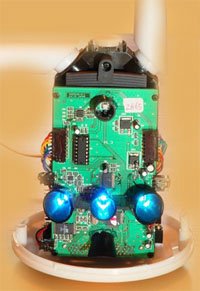
I think this is probably due to the fact this sort of design enables a large number of people to project on the creature what they want to find. Another explanation could be the unconscious memories of our very young life... Anyway, after discussing with some Nabaztag owners, there is a strong need to customize the creature in order to make it truly personal. Unfortunately, Violet has no offer for any customizing features (at this time) so users try to find another way by using socks, hats, ... I also don't agree with the fact that this interesting rabbit is the clear inverse of an open-system (even if there is a small API for programming applications). I think, on the contrary that Nabaztag users and the company itself would benefit from giving a free access to this technology in order to enable people to invent new usages that they have not even think about. From a technology point of view, the rabbit is based on a PIC18F 8-bit microcontroller and 8 Mbit of flash memory. The microchip controls all actuators, various LEDs and a PCMCIA Benq WIFI (B) card. Many people are trying to free the rabbit (nabaztools.sourceforge.net). Please Mr. Violet, help them…
Sunday, February 19, 2006
Bio-inspired Expiatory Temple

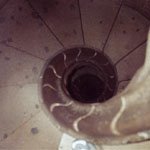 Beside my participation to the 3GSM World Congress in Barcelona (read earlier post) it was also an opportunity to visit the famous expiatory temple of the Sagrada Familia. Its construction began in 1882 and, one year later, Antonio Gaudi was apointed its project director. He worked on the projectover 40 years until his death in 1946. The temple is still underconstruction since this date, sponsorized by private donations.
Beside my participation to the 3GSM World Congress in Barcelona (read earlier post) it was also an opportunity to visit the famous expiatory temple of the Sagrada Familia. Its construction began in 1882 and, one year later, Antonio Gaudi was apointed its project director. He worked on the projectover 40 years until his death in 1946. The temple is still underconstruction since this date, sponsorized by private donations.There is a very interesting exhibition for all people interested in artificial life and bio-inspired architecture. It shows the origins of the organic architecture used by Gaudi in all his works.  Many architectural parts and details of the temple were designed using models quite common in nature in both flora and fauna.
Many architectural parts and details of the temple were designed using models quite common in nature in both flora and fauna.
 Many architectural parts and details of the temple were designed using models quite common in nature in both flora and fauna.
Many architectural parts and details of the temple were designed using models quite common in nature in both flora and fauna.The inside of the temple is like a forest of giant trees, with trunks, branches and masses of leaves as ceiling. Between them, some holes let us see the sunlight as in a large wood. The stairs inside each bell-tower (90 and 112 meters high) are based on the internal structure of seashells. Another example among may others is the geometric shape of a Gaudi Column based onthe helicoidal growth of leaves on an oleander branch.
Antonio Gaudi said himself: "I captured the purest and pleasing images of Nature, who is ever my Mistress."
Saturday, February 18, 2006
The Future will be Mobile
 This week I was at the 3GSM world congress in Barcelona, one among more than 50,000 participants. This is to say that it was, by any standart, a huge event. No wire and big business.
This week I was at the 3GSM world congress in Barcelona, one among more than 50,000 participants. This is to say that it was, by any standart, a huge event. No wire and big business. Beside all the new 3G handsets, MP3 and TV devices, nVidia was demonstrating its GoForce 5500 processor chip adding 3D graphics, image and sound processing to mobile phones. The prototype demo was showing a 3D avatar designed in OpenGL by the Go!Figure Mobile compagny. NEC was presenting its personal robot called PaPeRo. This small robot has a built-in mobile phone. NEC is looking for new applications as part of children's groups at daycare centers and kindergartens.
 When a parent calls PaPeRo, it locates the child using facial recognition and starts playing with him or her. The parent can then watch his child via the cameras in PaPeRo's eyes and the TV conferencing feature of the mobile phone. I'm not sure that this is the "killer app" for a 10,000$ robot, but who knows...
When a parent calls PaPeRo, it locates the child using facial recognition and starts playing with him or her. The parent can then watch his child via the cameras in PaPeRo's eyes and the TV conferencing feature of the mobile phone. I'm not sure that this is the "killer app" for a 10,000$ robot, but who knows... Sometimes ago, someone argued me that all these digital screens will make people alone and fixed at home. I rather think that people will continue to move, but with their screens, everywhere. Most people would rather leave home without their wallet than their own personalized mobile phone. There are roughly two billion of mobile phone users around the world. 3G is now ready and the next generation (4G) will be available near 2010. We are on the road towards the infosphere...
Sunday, February 12, 2006
May the force be with us
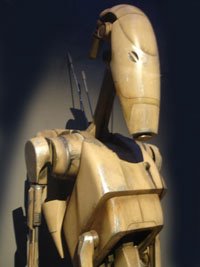 This afternoon I have visited the Star Wars exhibition at the"Cité des Sciences" in Paris... There is a strange relation between science & technology and science-fiction (SF). They respectively influence themselves in a deep and necessary loop. SF was made possible only by the rise of modern science itself. All SF Writers have been deeply influenced by the advances in science and technology. But in turn, scientists are also influenced by SF novels and movies. SF is an incubator for imaginative minds to create visions, to transport us beyond the horizon of our current technologies. SF enable us to "experiment" the possible incarnations of scientific progress not only as it is, but also as it could be, to paraphrase the terms coined by Christopher Langton for Artificial Life. In this sens, SF offers an imaginary window to possible futures.
This afternoon I have visited the Star Wars exhibition at the"Cité des Sciences" in Paris... There is a strange relation between science & technology and science-fiction (SF). They respectively influence themselves in a deep and necessary loop. SF was made possible only by the rise of modern science itself. All SF Writers have been deeply influenced by the advances in science and technology. But in turn, scientists are also influenced by SF novels and movies. SF is an incubator for imaginative minds to create visions, to transport us beyond the horizon of our current technologies. SF enable us to "experiment" the possible incarnations of scientific progress not only as it is, but also as it could be, to paraphrase the terms coined by Christopher Langton for Artificial Life. In this sens, SF offers an imaginary window to possible futures. Thursday, February 02, 2006
Dear AIBO enthusiast... bad news
Sad days for all people interested in artificial creatures… AIBO is dead !
« Following the Sony Corporation FY05 3Q announcement, the production of AIBO Entertainment Robots will be discontinued as of end March 2006. As for the sales activity, we will discontinue the sales of AIBO once all remaining stock runs out. »  « Sony as a whole will be focusing on three core business domains: electronics, games and entertainment, with an emphasis on profitability and strategic growth opportunities. In light of this focus, it has been decided to discontinue the AIBO business.
« Sony as a whole will be focusing on three core business domains: electronics, games and entertainment, with an emphasis on profitability and strategic growth opportunities. In light of this focus, it has been decided to discontinue the AIBO business. 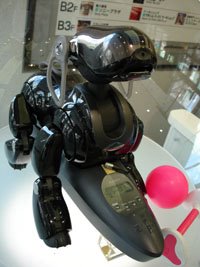 Sony is not planning any new research and development specifically for AIBO or QRIO products, but R&D for the elemental technologies (visual recognition, sound recognition, etc.) will continue for research on Artificial Intelligence. The knowledge and technology Sony has gained in robotics may possibly be applied to future Sony products. »
Sony is not planning any new research and development specifically for AIBO or QRIO products, but R&D for the elemental technologies (visual recognition, sound recognition, etc.) will continue for research on Artificial Intelligence. The knowledge and technology Sony has gained in robotics may possibly be applied to future Sony products. »
 « Sony as a whole will be focusing on three core business domains: electronics, games and entertainment, with an emphasis on profitability and strategic growth opportunities. In light of this focus, it has been decided to discontinue the AIBO business.
« Sony as a whole will be focusing on three core business domains: electronics, games and entertainment, with an emphasis on profitability and strategic growth opportunities. In light of this focus, it has been decided to discontinue the AIBO business.  Sony is not planning any new research and development specifically for AIBO or QRIO products, but R&D for the elemental technologies (visual recognition, sound recognition, etc.) will continue for research on Artificial Intelligence. The knowledge and technology Sony has gained in robotics may possibly be applied to future Sony products. »
Sony is not planning any new research and development specifically for AIBO or QRIO products, but R&D for the elemental technologies (visual recognition, sound recognition, etc.) will continue for research on Artificial Intelligence. The knowledge and technology Sony has gained in robotics may possibly be applied to future Sony products. »This is the end of the AIBO story that began in the early 90’s at Sony. Since its commercial launch in 1999 more than 150,000 AIBOs have been sold worldwide. I take this picture of the « last AIBO » at Sony Building in Tokyo last september. I suggest that it could be a good idea for Sony to make this technology available as an open-source project, instead of just being lost for everybody. We will miss you guys.
Thursday, January 26, 2006
EVA version 3 - Who's that girl ?
 This is the new 3D design for EVA (Evolutionary Virtual Agent). There are many improvements since the previous one (see last post on this subject). Now the student team is working on the screen setup and on the various face expressions: reference (no expression), happy, disapointed, annoyed, angry, etc. There are three main animation parts: left eye, right eye, and nose/mouth. Since all images are pre-calculated, we try to reduce the number of animations to a small set of primitives. The Java-based animation engine is quite simple since it is basically an image switching system. This is not the case for the AI Ghost which is far more complicated. I will try to describe it briefly in a future post. I have a question: could you recognize the (real) woman who inspired this virtual model ?
This is the new 3D design for EVA (Evolutionary Virtual Agent). There are many improvements since the previous one (see last post on this subject). Now the student team is working on the screen setup and on the various face expressions: reference (no expression), happy, disapointed, annoyed, angry, etc. There are three main animation parts: left eye, right eye, and nose/mouth. Since all images are pre-calculated, we try to reduce the number of animations to a small set of primitives. The Java-based animation engine is quite simple since it is basically an image switching system. This is not the case for the AI Ghost which is far more complicated. I will try to describe it briefly in a future post. I have a question: could you recognize the (real) woman who inspired this virtual model ?Monday, January 23, 2006
A 3D Hierarchical Multi-Agent System for studying Cosmological Complexity
 We have designed a hierarchical 3D multi-agent system for studying complexity at the cosmological level (see previous post on M31). Each agent is characterized by a set of properties: its position, velocity and mass, but also its diameter, density, viscosity, spin, etc. There are three simulation levels: (1) inside each agent (internal gravity that can lead to star formation, supernova, etc.), (2) local interactions between agents (viscosity) and (3) global interactions between agents (gravity and expansion).
We have designed a hierarchical 3D multi-agent system for studying complexity at the cosmological level (see previous post on M31). Each agent is characterized by a set of properties: its position, velocity and mass, but also its diameter, density, viscosity, spin, etc. There are three simulation levels: (1) inside each agent (internal gravity that can lead to star formation, supernova, etc.), (2) local interactions between agents (viscosity) and (3) global interactions between agents (gravity and expansion).  These two pictures (two different views of the same configuration) show an elliptical galaxy with an angular momentum. This dynamical structure has emerged from a random spatial distribution of 10,000 agents in the 3D space. Current thinking is that an elliptical galaxy is the result of a long process where two galaxies of comparable mass, of any type, collide and merge. This was not the case here...
These two pictures (two different views of the same configuration) show an elliptical galaxy with an angular momentum. This dynamical structure has emerged from a random spatial distribution of 10,000 agents in the 3D space. Current thinking is that an elliptical galaxy is the result of a long process where two galaxies of comparable mass, of any type, collide and merge. This was not the case here... Thursday, January 19, 2006
Complexity and Social Networks
 Do you know that anyone on earth can be connected to any other person through a chain of acquaintances that has no more than five intermediaries ? (Six degrees of separation theory). Do you know that the size of a genuine social network is limited to about 150 ? (Dunbar Number).
Do you know that anyone on earth can be connected to any other person through a chain of acquaintances that has no more than five intermediaries ? (Six degrees of separation theory). Do you know that the size of a genuine social network is limited to about 150 ? (Dunbar Number).What is the network model of my organization ? What are the emerging patterns and dynamics ? Is my company well adapted to its market ? How can I locate key players ? …
Social network theory views humans relationships as a network of agents connected through various acquaintances. The analysis of these networks is crucial for a better understanding in sociology, anthropology, organizational studies, economy and finance, etc. Within these domains, Internet plays a central role since online social networks (forums, chats, blogs, wikis, online games, etc.) are becoming increasingly popular. We can model such networks of interacting entities using classical approaches in the science of complexity: cellular automata, random networks, multi-agent system, etc. However, it appears to me that a hierarchical modeling could constitute a better approach (more precisely a hierarchy of intricated small-world agent-based networks). Let me try to explain why. First, it seems obvious that only multiple levels can reflect the complexity of real cases. At the lower level there is always a communication medium. For online social networks, this physical network is a graph of connected computers and servers, portable devices, mobile phones, etc. On top of this physical network, there are many possible different levels: individuals but also organizations, companies, countries, nations, etc., and other ones like social, cultural communities or any other forms of communities of interest. My second argument is that "classical" models are simple and universalist, let say: easy to model, to code and to understand. However, even they provide very interesting results in terms of emerging global dynamics and trends, they are generally inadequate for modeling a specific case to obtain practical informations. I think that the study of hierarchical multi-agent systems for modeling (online) social networks represents a promising approach and could contribute to give useful results in many real-world applications.
Tuesday, January 17, 2006
EVA version 3 - Preliminary 3D model
 Here is the first 3D model for EVA (Evolutionary Virtual Agent) based on the preliminary drawings done in December (see previous post on EVA). This is a draft design since the model is not yet completed and there is no texture, no light, etc., but it gives a good idea of what will be the look of the final rendered face. All the 3D design is done by a student team of the IIM school (International Institute of Multimedia) using the 3DS Max Sofware tool. At the same time, I have coded near 60% of the Java-based AI "ghost" that will animate the model. The next steps are: (1) complete the face model and (2) test a working ghost with reactive behaviors (no genetic programming). Then, we will add animations and more complex behaviors. More information later. Keep tuned.
Here is the first 3D model for EVA (Evolutionary Virtual Agent) based on the preliminary drawings done in December (see previous post on EVA). This is a draft design since the model is not yet completed and there is no texture, no light, etc., but it gives a good idea of what will be the look of the final rendered face. All the 3D design is done by a student team of the IIM school (International Institute of Multimedia) using the 3DS Max Sofware tool. At the same time, I have coded near 60% of the Java-based AI "ghost" that will animate the model. The next steps are: (1) complete the face model and (2) test a working ghost with reactive behaviors (no genetic programming). Then, we will add animations and more complex behaviors. More information later. Keep tuned.Friday, January 13, 2006
The New Furby
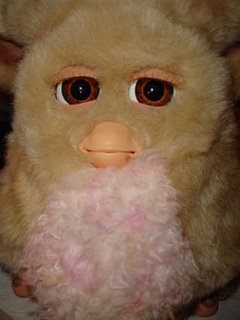 For Christmas, I bought the New Furby which was released in France at the end of the year. It is an advanced toy considering its technology and its relatively low price (near 50€ in France and less than 40$ in the US). The Furby looks like an armless Greemlins Mogwai with a beak. Evidence is that the New Furby cannot be considered as a living creature. However what is the opinion of my expert (Lara, 5 years old):
For Christmas, I bought the New Furby which was released in France at the end of the year. It is an advanced toy considering its technology and its relatively low price (near 50€ in France and less than 40$ in the US). The Furby looks like an armless Greemlins Mogwai with a beak. Evidence is that the New Furby cannot be considered as a living creature. However what is the opinion of my expert (Lara, 5 years old):- Is Furby living ?
- Of course yes !
- Why ?
- Because it moves and it speaks to me...
Ok, well done Tiger (Furby is a product of Hasbro Inc.'s Tiger Electronic division). The New Furby is powered by the Sensory Inc's RSC-4128 ship which is a multi-purpose (14 Mhz max) microprocessor: voice recognition, text-to-speach, various input-output sensors and actuators, DTMF output, etc. Its documentation is easily accessible on the Web, but there is no information on the operating software called "Emoto-tronics" designed for the Furby. Even if the New Furby is a successfull toy, it lacks in many points from my point of view: (1) It reacts slowly to most events (probably needs a more powerful CPU and/or realtime programming). (2) It always repeats the same behaviors (needs more randomness/a larger set of behaviors). (3) The efficiency of learning is not so clear.... Some people like Benjamin Stove (blog at eecue.com) are working on "hacking" the New Furby. I think it could be very interesting to be able to reprogram this amazing toy using for example a subsumption architecture, genetic programming, etc. Avis aux amateurs...
Tuesday, January 10, 2006
Conway's Glider and Minimal Life
The Game of Life is certainly the most familiar Cellular Automata. It was introduced by John Conway in 1970 and popularized by the Scientific American journal. The Glider, a simple oscillating pattern that moves in the life universe, is generally presented as an emerging structure that gives an idea of what could be a minimal living creature. Is the Glider a useful modelof a living system ?
The Glider is a configuration of five "on" (black) cells that moves diagonally every four cycles. It represents a good example of a self-reproducing loop but it is far more simple than the self-reproducing automata proposed by John von Neumann in his theory. The Glider is a coherent pattern in space-time that continuously reconstitutes itself in the meaning of Maturana and Varela's notion of Autopoiesis. In the figure, I have colored in blue the "off" cells that contribute to its structure, forming a sort of membrane. However, the glider cannot be considered as a full autopoietic system since it is very sensible to any perturbation: most interactions with other structures are destructive. I personnaly think that the glider is too simple to represent a convincing model for minimal life, but it gives us a feeling of what it could be.
Saturday, January 07, 2006
Strasbourg Automata Clock
 This week I was invited to give a talk on the evolution of complexity at the "Faculté de Géographie et d'aménagement" (Louis Pasteur University) in Strasbourg (Thanks to Christiane Rolland-May and her team). It was also an opportunityto take a picture of its famous astronomical clock. The Strasbourg cathedral clock has a long history. The first clock was built in around 1352. It was replaced in 1547 but due to the religious turmoil of the time, the work was not completed until some thirty years later. Some modifications and work took place again in the 19th century.
This week I was invited to give a talk on the evolution of complexity at the "Faculté de Géographie et d'aménagement" (Louis Pasteur University) in Strasbourg (Thanks to Christiane Rolland-May and her team). It was also an opportunityto take a picture of its famous astronomical clock. The Strasbourg cathedral clock has a long history. The first clock was built in around 1352. It was replaced in 1547 but due to the religious turmoil of the time, the work was not completed until some thirty years later. Some modifications and work took place again in the 19th century.
The clock includes a collection of automata: a cherub turningan hour glass, another hitting a gong and a figurative representationof the four ages of man. It represents an important step in the history of artificial creatures before the Lumière century and the automata designed by Jacques de Vaucanson in France and the Jaquet Droz in Switzerland. I am finishing to write a reference book on the history of artificial creatures: near 800 pages and more than 200 illustrations ! More information soon...
Wednesday, January 04, 2006
New year in the desert
 The weather was so cold in Paris that we decided to go in the south Tunisian desert for the last days of 2005 :)
The weather was so cold in Paris that we decided to go in the south Tunisian desert for the last days of 2005 :)This travel gives me the opportunity to observe (and take pictures) many forms of complex natural landform patterns. Sand dunes represent a good example of rich emergent patterns produced by the nonlinear interactions between a very high number of simple agents : sand particules. Sand dunes formation has one basic cause: the transport of sand grains by the wind. They generally start small and disorganized due to the large number of degrees of freedom of sand grains. Once sand begins to pile up, ripples and dunes form. The wind moves individual grains along the inclined windward surface until they reach the crestand then cascade down the steep leeward side. Dunes formation relies upon the weight and size of the sand grains in relation to the wind force. Fine sand particles tend to produce a strong relief, the dunes having a short wave length, while coarse sand produces rounded dunes with a long wave length.
The sand accumulates into ridges which originally lie parallel to the direction of the prevailing winds. Over time these ridges create more irregular arrangement of hills and hollows. Global patterns emerge through interactions and mergers between these forms. Crescent shaped wind blown dunes spawn new dunes from their downwind pointing horns. This could be viewed as some sort of a simple self-reproduction mechanism.
Subscribe to:
Posts (Atom)

